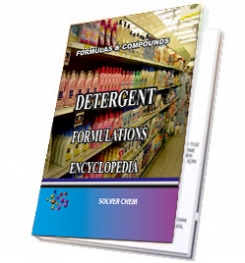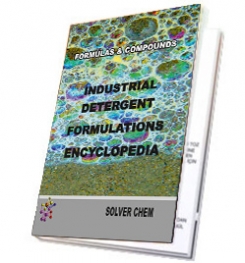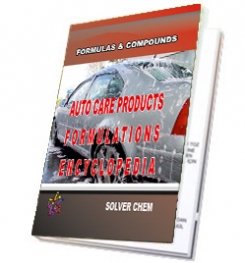Soaps or detergents are cleansing agents that are capable of reacting with water to dislodge these foreign particles from a solid surface (e.g. cloth or skin). Soaps have their origin in oils and fats present in the animal and plant kingdom and synthetic detergents find their source in mineral oils (hydrocarbon compounds of petroleum or coal). Chemically speaking, Soaps are sodium or potassium salts of higher fatty acids like stearic, palmitic and oleic acids can be either saturated or unsaturated. They contain a long hydrocarbon chain of about 10-20 carbon with one carboxylic acid group as the functional group.
Saturated fatty acids such as stearic and palmitic etc. contain only single bonds in their molecule, while unsaturated fatty acids such as oleic, linoleic etc., contain one or more double bonds. Thus, soaps are usually a mixture of the sodium salts of the following acids:
- Stearic acid as sodium stearate (C17H35COONa) - saturated fatty acid; from vegetable oils like linseed oil, soyabean oil.
- Palmitic acid as sodium palmitate (C15H31COONa) - saturated fatty acid; Palm oil, animal fat
- Oleic acid as sodium oleate (C17H33COONa) - unsaturated fatty acid; Vegetable oils like linseed oil, soyabean oil.
- When soap is made from the sodium salts of the acids of cheap oils or fats, the resulting soap is hard. These soaps contain free alkalis and are mainly used as washing bars for laundry. When soap is prepared from the potassium salts of the acids of good grade oils and fat, it results in soft soap. These soaps do not contain free alkalis. They produce more lather and are used mainly as toilet soaps, shaving cream and shampoos.
Difference between Toilet Soap and Laundry Soap
| Toilet Soap | Laundry Soap |
| High quality fats and oils as raw materials. | Cheaper quality fats and oils. |
| Expensive perfumes added. | Cheap perfumes added. |
| Care is taken to ensure that there is no free alkali content to prevent injuries to skin. | No such care is taken. |
| No fillers. | Fillers present. |
Activity
How can you make soap at home or in class by using any vegetable oil, caustic soda and common salt?
Suggested answer
Take about 25 ml of a vegetable oil such as castor oil or groundnut oil in a beaker. Add about equal volume of concentrated solution of caustic soda (sodium hydroxide) to it. Heat the mixture slowly with stirring until it boils and a creamy paste of soap is formed. Boil further for 10-15 minutes. About 5 g of common salt (sodium chloride) is now added to precipitate out all the remaining soap from the aqueous layer. On cooling the solid soap separates out at the surface. It is drawn out put into moulds or small trays, dried and used.
Cleansing Action of Soap
A soap molecule a tadpole shaped structure, whose ends have different polarities. At one end is the long hydrocarbon chain that is non-polar and hydrophobic, i.e., insoluble in water but oil soluble. At the other end is the short polar carboxylate ion which is hydrophilic i.e., water soluble but insoluble in oil and grease.
When soap is shaken with water it becomes a soap solution that is colloidal in nature. Agitating it tends to concentrate the solution on the surface and causes foaming. This helps the soap molecules make a unimolecular film on the surface of water and to penetrate the fabric. The long non-polar end of a soap molecule that are hydrophobic, gravitate towards and surround the dirt (fat or oil with dust absorbed in it). The short polar end containing the carboxylate ion, face the water away from the dirt. A number of soap molecules surround or encircle dirt and grease in a clustered structure called 'micelles', which encircles such particles and emulsify them.
The subsequent mechanical action of rubbing or tumbling dislodges the dirt and grease from the fabric. These get detached and are washed away with excess of water leaving the fabric clean.
Limitations of Soaps
Soaps do not wash well in hard water and does not form much lather or foam. The calcium, magnesium or iron ions of hard water form an insoluble sticky gray coloured precipitate called scum, which restricts the cleansing action of soap and makes washing more difficult. The scum formed also hardens and dis-colours the fabric. Thus, a large amount of soap is wasted and cleaning is not efficient.
To overcome these drawbacks new types of chemical based cleansing agents were developed. These are called synthetic detergents or simply detergents.
Synthetic Detergents
A detergent is a non-soapy cleaning agent that uses a surface-active agent for cleaning a substance in solution. Synthetic detergents are described as soapless soaps. Unlike soaps they are effective even in hard or salt water, as they form no scum.
Modern synthetic detergents are alkyl or aryl sulphonates produced from petroleum (or coal) and sulphuric acid. They can be defined as 'the sodium or potassium salt of a long chain alkyl benzene sulphonic acid or the sodium or potassium salt of a long chain alkyl hydrogen sulphate that have cleansing properties in water'.
Like soaps, detergents contain one large non-polar hydrocarbon group and one short ionic or highly polar group at each end, which allow for the cleansing action of dirt in water. Two basic examples of well-known detergents of the sulphonate group ![]() or the sulphate group
or the sulphate group ![]() are:
are:

Cleansing Action of Detergents
Synthetic detergents have the same type of molecular structure as soaps i.e. a tadpole like molecule having two parts at each end i.e., one large non-polar hydrocarbon group that is water repelling (hydrophobic) and one short ionic group usually containing the![]() or
or ![]() group that is water attracting (hydrophilic). Thus the cleansing action is exactly similar to that of soaps whereby the formation of micelles followed by emulsification occurs. However, synthetic detergents can lather well even in hard water. This is because they are soluble sodium or potassium salts of sulphonic acid or alkyl hydrogen sulphate and similarly form soluble calcium or magnesium salts on reacting with the calcium ions or magnesium ions present in water. This is a major advantage of the cleansing property of detergents over soap.
group that is water attracting (hydrophilic). Thus the cleansing action is exactly similar to that of soaps whereby the formation of micelles followed by emulsification occurs. However, synthetic detergents can lather well even in hard water. This is because they are soluble sodium or potassium salts of sulphonic acid or alkyl hydrogen sulphate and similarly form soluble calcium or magnesium salts on reacting with the calcium ions or magnesium ions present in water. This is a major advantage of the cleansing property of detergents over soap.
-
RELATED TAGS : what is fatty acid,how to obtain fatty acid,how to use fatty acid,where to use fatty acid,fatty acid msds,what is natural soap,how to make natural soap,how to compounds and formulas of natural soap,how to clean natural soap,what is formulas of natural soap,where to use fatty acid,property of fatty acid,cleaning action of soap,cleaning action of soap.
-
- Ordinary soaps are not suited for fabrics such as silks, wool etc. The alkalis in them injure the fiber.
-
If the water is slightly acidic in nature soaps cannot be used for cleaning purpose. The acid media change soaps into carboxylic acid and the action of soap becomes ineffective.
- Since detergents are the salts of strong acids they do not decompose in acidic medium. Thus detergents can effectively clean fabric even if the water is acidic.
- Synthetic detergents are more soluble in water than soaps.
- They have a stronger cleansing action than soaps.
- As detergents are derived from petroleum they save on natural vegetable oils, which are important as essential cooking medium.
- Many detergents are resistant to the action of biological agents and thus are not biodegradable. Their elimination from municipal wastewaters by the usual treatments is a problem.
- They have a tendency to produce stable foams in rivers that extend over several hundred meters of the river water. This is due to the effects of surfactants used in their preparation. Thus they pose a danger to aquatic life.
- They tend to inhibit oxidation of organic substances present in wastewaters because they form a sort of envelope around them.
-
Advantages of Detergents
Synthetic detergents clean effectively and lather well even in hard water and salt water (sea water). There is no scum formation.
Disadvantages of Detergents
Detergents are surface-active agents and cause a variety of water pollution problems.
Differences between Soaps and Detergents
Soaps Detergents They are metal salts of long chain higher fatty acids. These are sodium salts of long chain hydrocarbons like alkyl sulphates or alkyl benzene sulphonates. These are prepared from vegetable oils and animal fats. They are prepared from hydrocarbons of petroleum or coal. They cannot be used effectively in hard water as they produce scum i.e., insoluble precipitates of Ca2+, Mg2+, Fe2+ etc. These do not produce insoluble precipitates in hard water. They are effective in soft, hard or salt water. These cannot be used in acid solutions. They can be used even in acid solutions. Their cleansing action is not as strong as that of detergents. Their cleansing action is by surfactants, which is a strong cleansing action. These are biodegradable. Some of these are not biodegradable.
If a straight chain hydrocarbon is used in the detergent instead of a branched chain hydrocarbon, then the detergent becomes biodegradable. Thus the major disadvantage of detergents can be overcome.

RELATED TAGS: RAW MATERİALS OF DETERGENT,DETERGENT CHEMICALS,MAKING DETERGENT,HOW TO MANUFACTURING DETERGENT,DETERGENT PRODUCTION,LIQUID DETERGENT,DISHWASHER DETERGENT,DISHWASH DETERGENT,PROPERTIES OF DETERGENT,DETERGENT MSDS,HOW TO USE DETERGENT,HOW TO PROCESS OF DETERGENT,METHODS OF DETERGENT MAKING.
DETERGENT AND PRODUCTIONS
POWDER DETERGENT PRODUCTION is not very complicated. For the production, there is need usable and tried a formulation, raw materials and mixing tank. For raw materials to be used, quantities to be used and ingredients usage rankings, you should look into this formulation. Therefore, formulation and productıon methods of detergent are important. If you have not a good formulation, you cannot make healthy and efficient production of any detergent.If you need any manufacturing formulations and production methods about
powder detergent,
DETERGENT
FORMULATIONS
ENCYCLOPEDİA
is enough.
This encyclopedia has many formulations of dishwasher cleaning products,dishwashing liquid production,kitchen cleaner products,laundry produts, powder laundry detergent,gel laundry detergents,liquid bleach products,powder bleach products formulations,surface cleaner products manufacturing process,multipurpose cleaner products,metal cleaners,bathroom cleaning products formulations,liquid soap formulations,antibacterial soaps,carpet shampoo,carpet cleaner detergent manufacturing processes, etc.
All detergent in the encyclopedia are producible easily.You need no help and no technıcal support. The encyclopedia is enough to produce liquid and powder detergent itself.
DETERGENT
FORMULATIONS
ENCYCLOPEDIA
is written clear and understandable.
RELATED TAGS: What is powder detergent, how to make powder detergent, making powder detergent, powder detergent manufacturing process, powder detergent production, formulations of powder detergent, types of powder detergent, anionic surfactant, detergent dyes, detergent fragranges, how to make powder detergent, preparation of powder detergent, cationic surfactant, anionic surfactants, detergents ingredients, how to use detergent ingredients, where to use surfactants, properties of powder detergent, machine of powder detergent, how to make powder detergent mixer, composition of powder detergent, production formulation of powder detergent, using powder detergent. compounds of powder detergent.
DETERGENT ENCYCLOPEDIAS AND CONTENTS


E - BOOKS AND HARD BOOKS
HOW TO BUY
DETERGENT ENCYCLOPEDIAS AND VIDEOS

|
|

|
|

|
|


